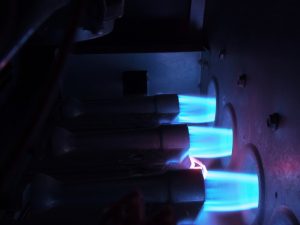 If you’re like the majority of homeowners in our area, then a natural gas furnace is your system of choice to warm up your home during a chilly winter. Sure, our winters may be relatively mild compared to Midwest and some East coast residents, but that doesn’t mean the contrast in temperatures doesn’t get to us—we need a fully effective and efficient heater in our homes, right?
If you’re like the majority of homeowners in our area, then a natural gas furnace is your system of choice to warm up your home during a chilly winter. Sure, our winters may be relatively mild compared to Midwest and some East coast residents, but that doesn’t mean the contrast in temperatures doesn’t get to us—we need a fully effective and efficient heater in our homes, right?
Gas furnaces are definitely the way to go for most of us—they produce a large amount of heat and do so at less expense than their electric-powered counterparts since natural gas costs less than electricity per unit.
However, it’s important to note that any natural gas appliance has the potential to develop safety issues—particularly aging systems that haven’t had proper maintenance each year. A well-maintained gas furnace will give you very little to worry about, and no gas furnace is inherently dangerous, but proper care is vital.
Why’s this? Because without proper care, an aging and ill-maintained furnace may end up with a cracked heat exchanger!
“Wait, What’s a Heat Exchanger?”
This is the component that actually enables your furnace to heat up the air that travels through the ventilation system. When the burners of the furnace come on, they generate hot combustion gas, which is collected inside the heat exchanger—a metal chamber or series of chambers that resemble a clam-shell shape.
The hot combustion gas within the heat exchanger heats up the metal walls, and the blower fan of your furnace then cycles on to send air around the exchanger, where it picks up the heat from the furnace wall and continues into your ductwork.
Through this process, the combustion gas heats the air without the gas ever needing to come in contact with it—that is, so long as the heat exchanger isn’t damaged.
Once the heating process is complete, the combustion byproducts in the heat exchanger are vented out of the system through a flue to release the gas harmlessly into the outside air.
A Cracked Heat Exchanger
Since the metal of the heat exchanger expands and contracts as it heats and cools down, the stress can eventually cause a crack to form on the exchanger. As we alluded to above, this is something that is checked during your annual maintenance appointment, and you probably don’t need to worry about too much with a newly installed furnace (so long as that installation was done by a pro!)
But corrosion due to the reaction between the combustion gas and the metal—usually because of improper venting—weakens the metal to the point where damage occurs. A crack or two in a heat exchanger can be extremely small, but when the exchanger heats up it expands, opening enough to allow carbon monoxide gasses to escape and enter your living space.
“So, What Happens If I Already Have a Cracked Heat Exchanger?”
First off, if you suspect you have a cracked heat exchanger (you may hear a clicking noise as your furnace is running or your CO detector might have gone off) then the first thing you should do is shut off your furnace and call us for emergency repairs.
If you haven’t noticed any signs but are wondering just the same, it never hurts to give us a call. This is especially true if it’s been more than a year since your last furnace tune-up.
Contact Comfort Flow Heating to service your gas furnace in Salem, OR!

